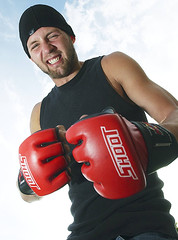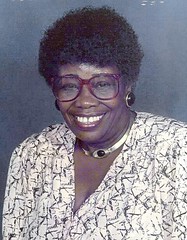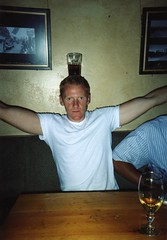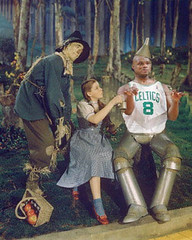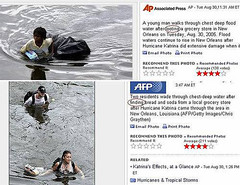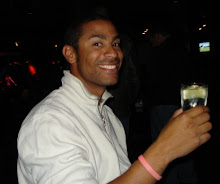The Big Nasty
I play basketball with this guy about three times a week. He's one of those guys that just KILLS me to see playing rec ball, because he's got sooooo much damned talent, and just no sense at all. Darren could be playing pro and making a six-figure income right now, but he just has no sense at all. And then there's me, who is just the opposite - lots of heart, not enough talent.
Anyways, I wrote a column about Darren's latest escapades - Ultimate Fighting - for my column last Friday. For pics on the event, check it out HERE..
FROM THE HARDCOURT TO HARD RIGHT HOOKS
A year ago, Darren Apels was “goon central.”
The basketball player was eminently proud of his bad-boy attitude, threw sucker-punches during college games, called himself “Big Nasty” and yearned for a career in the WWE. His career goal, if pro basketball didn’t work out, was to be a mean-spirited gym teacher who would alternate between ignoring his charges or reducing them to tears.
Now we can add ultimate fighter to his resume.
Apels, 24, fought in his first professional mixed martial arts event last Friday, entering the squared circle at the Maximum Fighting Championships at the Shaw Centre in Edmonton.
The former Okanagan University College basketball star took on Jim Dobson, a six-foot-five, 278-pound, shaven-headed behemoth with more than a dozen pro fights under his belt, and — believe it — knocked him out in the first round.
“I’m still shocked,” said the six-foot-seven, 215-pound Apels, who’s better known for his basketball skills, having played junior college in New York City and attending several invitation-only camps for Team Canada.
Apels’ previous punch of notoriety was a sucker-punch during a junior college game while playing for the Global Institute of Technology in 2004. But his straight right at 2:26 of the first round against Dobson might just have changed that.
Dobson came out charging, throwing a flurry of wild punches, but when the fight found its way to the mat, he was the man bleeding like a stuck pig. After a restart — the ref stopped the fight to check the gash between Dobson’s eyes — Apels fended off another charge, then clocked Dobson with an overhand right that sent him sprawling to the canvas.
“I remember the guy being all bloody,” he said. “He had hit me pretty good, and caught me on the chin a couple times during the first minute. He just teed off on my chin. When I got him on the ground, and we were bleeding, I actually thought it was me, but he had this big gash down the middle of his face.
“I was happy it wasn’t me, because I want to be a GQ cover model.”
Ahh, yes. The famous Apels wit. It was put on display for the 2,000 fans in attendance in Edmonton, as the Vernon-born basketball player turned brawler hit on the ring girl (“She was amazing. I called her ‘Princess,’” he said) while Dobson was trying to stare him down.
His post-fight interview consisted of “line ’em up, ’cause I’m going to the beer gardens.”
But he wasn’t feeling so cocky as he made his way into the ring.
“It was crazy. I didn’t have any experience. I don’t even think I’ve been in a fight at the bar in years,” he said. “I was really nervous. I wanted to go out the exit when I was walking down for my intro. There was so much smoke . . . I wanted to run out the back door and just not be seen again.
“I did get a nice ovation, though. They booed the (crap) out of the other guy.”
Apels had been scheduled to fight Victor (The Matrix) Valimaki — who upset legendary UFC fighter Dan (The Beast) Severn in the main event — but found out a week before that he was moving up a weight class to fight Dobson.
(Cue theme to “Rocky”) So Apels began the most intense training of his athletic career. Or, at least, he should have, considering he was about to enter an arena where he could suffer a serious injury.
“Man, I didn’t even train for this fight at all,” he said. “These guys, they go to the gym all the time, eat raw eggs . . . Me, I was just like, wake up, smoke weed and play Tiger Woods. I was more concerned about making my weight than I was getting in the ring.”
The fights will be aired on pay-per-view sometime next month. Despite his glib attitude, Apels was impressed by the strength and skill of the fighters who fought after him.
“They wanted to see if a basketball player could cut it in the ring. They know they can now,” he said. “I do give credit to all those fighters, though. Those guys are crazy. They’re nuts, man.
“I think I’ll probably continue with UFC. I’ll take it seriously . . . probably hold off on the drinking and smoking. I want to learn some of the moves and how to actually do stuff. I might even do some cardio.
“I might even try pro wrestling. I don’t mind doing the crazy stuff right now.”
